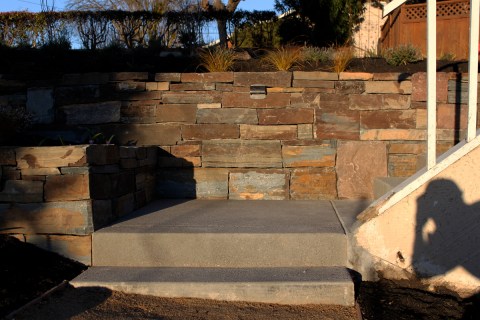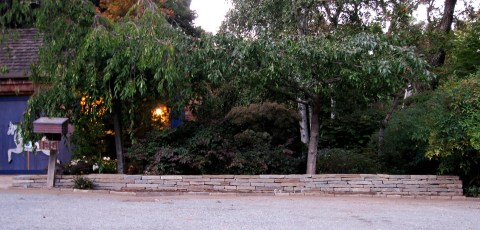The Gardens at Alcatraz
I went to Alcatraz last week for the first time since a field trip in grade school. Wow, I should of gone sooner. It’s a fascinating spot and more than just a place to take out-of-town visitors.
The prison is of course iconic and there are great views of the Golden Gate and the rest of the bay, but also the island has some of the most historic gardens in California. They were started by the military in the 1850’s on soil brought over from Angel Island, and then various soldiers, jailers, and inmates expanded and maintained the gardens throughout the years as the island went from fort to military prison to federal prison. The gardens were abandoned when the prison was closed down and a lot of the island was swallowed up by weeds, but a lot of the tougher plants held on. In 2003 the Garden Conservancy took over the gardens and began restoring them. Many, many, many hours of volunteer labor have gone into them. Restoration seems to be about developing or preserving the dichotomies of Alcatraz: a prison garden full of escaped exotics, a weeded garden ruin, wild plants in one of the most human-built sites in California.
There are a ton of different building materials throughout the island, with various types of concrete, stone, and brick mixed and layered in funky ways reflecting the island’s transformations from fort to military prison to prison. Even in the calla lily photo there are two different types of stone. The brickwork in the photo below almost looks like a tapestry the way it is outlined by what were originally the corners of separate stone walls.
I’m not sure what plants are naturalized from before and which ones have been added by the Garden Conservancy. There’s an extensive website for the gardens, including a blog, with a lot of photos and information about the history of the gardens. Quite a few garden bloggers have visited the island; Saxon Holt at Gardening Gone Wild, Far out Flora, and Oakland Guerrilla Gardener are two of the ones I know about.
This hand-carved granite doorway was built when the prison was still a fort. In the upper corners are two pulleys from the original drawbridge door.
The Tilden Plant Sale
I don’t post about many garden events, but one of my favorites is coming up on Saturday, the native plant sale at Tilden. It’s their biggest event of the year with many great plants for sale, some of them quite hard to find. The rush to the Trilliums is the single most frenzied horticultural moment I know of. (Speaking of which, I don’t know if it has been my luck or some kind of bumper year for Trilliums, but I have seen more of them this spring than ever before. I’m curious if that has been anyone else’s experience as well.) The sale starts at 10AM, with people starting to line up about an hour beforehand.
Wall Lighting
A little before we left for Belize I finished a project in Walnut Creek that I’d been working on for a while. No garden is ever truly finished and there are still a few things to do in this one — redoing the handrailing, painting the wall — but I’m not the one responsible for that phase so I get to call it done. Much of this project was done during the period of heavy winter rains in December and then there was a long delay while the light fixture for the wall was decided on and then fabricated. Landscape lighting generally gives more immediate gratification than any other aspect of landscaping, but we had a hard time finding the right fixture for this one. There are tons of lantern-style lights designed for eight-foot-high stuccoed walls, but not many for a three foot retaining wall of stone.
Some photos of lighting (which for some reason has attracted the biggest flurry of spam that I’ve seen in a long time) are below. Read the rest of this entry »
Watercolor Belize
We’re back. We had a great time in Belize. We were on a five acre island called Tobacco Caye for most of the time; our big accomplishment was going five days without putting on shoes or sandals. I have some photos of the Mayan ruins at Altun Ha on the mainland, but it’ll be a little while before I find time to post them. In the meantime, here is Anita’s watercolor of the place where we stayed. A couple of photos from Tobacco Caye are below. Read the rest of this entry »
Gone South
We’re off to Belize for a short vacation. We were planning to go to Joshua Tree, but that didn’t sound restful enough; sometimes vacation needs to include a beach. I should have a post or two on the Mayan ruins and the plants when I get back.
Before leaving, I wanted to make note of the deciduous plants in our yard on the same date, March 23, that I did last year. A few plants are earlier this year, somewhat more of them are a little behind, overall the lists are very similar. Last year’s list is here, this year’s is below the fold. Read the rest of this entry »
Elk Mtn. Tumbled Edging with Flowers
Thursday while I was down on the peninsula, I passed near a house where I did a small stone project last fall, so I stopped by to check out the planting that the client did afterwards. Pretty nice, and fun to see someone else’s plant choices. There wasn’t a drawing or anything when I did the project, just a request for an 8″ high wall to give a back drop to a low planting of color, and I didn’t know exactly what would go in afterwards. You can’t see so much of the stonework at the moment, but it will reappear as the plants finish their bloom cycles.
The yard had nice trees and shrubs before, but it’s a lot more interesting now. This photo from when I finished the project was in my 2010 wrap-up post.























